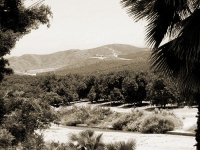
When western
Riverside County residents think about their water supply, Diamond Valley Lake often
comes to mind. This man-made lake southwest of Hemet is the largest freshwater reservoir
in Southern California, with a mind-boggling capacity of 260 billion gallons or
roughly 800,000 acre-feet of water.
But close as it may be to homes and businesses in Hemet and San Jacinto, Diamond
Valley Lake is controlled by Metropolitan Water District as a backup supply for
its 18 million customers in 26 cities and water districts across Southern California.
Although Lake Hemet Municipal Water District is located in the Metropolitan service
area, it is not likely to draw water from Diamond Valley Lake. Our water, our history
and our destiny, are instead tied to Lake Hemet, to the San Jacinto River and to
the pine and cottonwood-lined streams in the San Jacinto Mountains to the east.
Indeed, the development of the San Jacinto Valley itself can be traced back to 1887
with the formation of the Lake Hemet Water Company and the Hemet Land Company by
Edward L. Mayberry, his wealthy San Francisco friend, William F. Whittier and their
partners. These two companies allowed the partnership to acquire land and water
rights from the San Jacinto Valley to the west end of Garner Valley in the San Jacinto
Mountains.
Lake Hemet Water Company began building the dam that created Lake Hemet in 1891.
And by 1895, when this arched structure was completed it stood at 122.5-feet and
was the largest solid masonry dam in the world, a title it would retain until 1911
when the Roosevelt Dam was constructed in Arizona.
Mule Teams Aid Historic Dam Construction
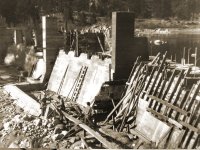
While diminutive
by today's standards, the Lake Hemet Dam was an extraordinary undertaking in the
late 1800s, according to Mary E. Whitney, a former Lake Hemet Municipal Water District
employee and historian who has written several books and newspaper articles detailing
the early history of Hemet and San Jacinto. Dam construction could not even begin,
she noted, until a road wide enough for supply-laden wagons and six-mule teams could
be constructed from Hemet to Garner Valley.
"Designed by Mayberry, but constructed by Proctor and Marriage of San Jacinto, the
road was necessarily steep with many switchbacks so six-mule teams could rest while
maneuvering their ascending loads of supplies, equipment and 400-pound barrels of
cement," Whitney wrote in an article published in
The Valley Chronicle.
How steep? Early historical accounts tell us that on parts of the canyon road freighters
encountered grades as steep as 18 percent.
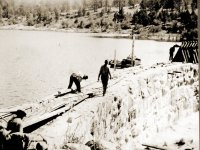
The reservoir
site itself also had to be cleared of pine trees, which were sawed into 1 million
board feet of lumber. Half of the wood was used for buildings and stagings at the
dam, with the remainder being hauled down the canyon for use as building flumes,
scaffolding and forms for construction.
Even acquiring the cement needed for the project was a challenge. The cement used
in the dam was the Portland type, which hardens under water. But since no Portland
cement plants existed in the western United States, the cement was purchased from
sources in Antwerp, Belgium and shipped around South America to the port of San
Diego, where it was then placed on railroad cars and transported to San Jacinto.
At that point, the cement was loaded onto wagons drawn by the mule teams for the
steep and dusty ascent up the mountain.
Upon its arrival at the construction site, the cement was used to hold together
thousands of quarried, 5- to 15-ton granite stones from surrounding bluffs, which
comprised much of the dam. After each stone was quarried, it was picked up and moved
to the dam on carriers suspended by two sets of 800-foot cables that were strung
across the canyon in opposite directions. Steam engines were used to move the cables
back and forth.
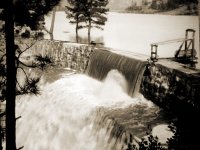
While an extensive system was developed to deliver construction materials to the
dam site, historical accounts indicate that construction was halted from time to
time due to bad weather and floods, particularly in 1892 and 1893. The dam, completed
in October of 1895, helped to capture the precious snowmelt and rainwater that would
nurture and sustain the apricot, walnut, olive and citrus groves of the San Jacinto
Valley. The region's water reserves, and its growth potential, were further increased
in 1923, when Lake Hemet Water Company added another 12.5 feet to the dam, raising
its height to 135 feet.
The Formation of Lake Hemet Municipal Water District
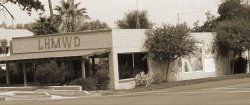
Lake Hemet
Water Company succeeded in providing much of the water needed to nourish and develop
the San Jacinto Valley during the first half of the 20th century. However, a severe
drought during the late 1940s and early 1950s, combined with population growth and
the need for significant infrastructure upgrades, created a combination of crises
that ultimately led to the sale of the company's assets and to the formation of
a municipal utility.
"The whole system had reached the point where it needed increasing amounts of maintenance,"
recalled Walter Bothner, a former Lake Hemet Municipal Water District board member
(1968 - 1994) and retired apricot farmer whose family came to the valley in 1914.
The drought also prompted many valley residents to call for the importation of Colorado
River water to supplement local supplies. A new utility, Eastern Municipal Water
District (EMWD), was created in 1950 specifically for this purpose. But while EMWD
succeeded in bringing much needed water to western Riverside County by tapping into
Metropolitan Water District's distribution system, many residents of Hemet and San
Jacinto did not want to surrender control of their water resources to outsiders.
"They were intensely local," Bothner said, "and many were in favor of keeping control
of the water supply for the District in local hands."
Lake Hemet Municipal Water District was formed in 1955 after a successful bond initiative
raised sufficient funds to purchase the assets of the Lake Hemet Water Company.
At that time, the District had approximately 1,800 customers and a 23-square mile
service area.
Since then, however, the District's service area and customer base have grown, mirroring
the rapid business and residential growth that has taken place in other locations
across western Riverside County. The District has also annexed additional service
areas, including the Garner Valley community in the San Jacinto Mountains east of
Lake Hemet. Today, the District serves nearly 14,500 customers in a 26-square mile
area that includes portions of Hemet, San Jacinto and adjacent unincorporated areas
of Riverside County.
Many Hemet residents have been around long enough to see Lake Hemet Municipal Water
District change with the times, including Leroy Hamilton, who worked for the District
from 1950 to 1991, starting as a ditch digger and working his way up to operations
supervisor. Reflecting on the past half century, Hamilton said the District has
evolved from being primarily an irrigation service to a fully developed domestic
water utility.
"But while the District was originally formed out of a local desire to retain independent
control over our water resources, the dual realities of population growth and the
limits of local water supplies make it increasingly important for the District to
proactively plan for future infrastructure improvements, to work collaboratively
with EMWD and other agencies, to jointly manage our local groundwater resources,
and to secure supplemental water supplies.
Indeed, while Lake Hemet and the streams that cascade down the west slope of San
Jacinto Mountains, including the North Fork and South Fork of the San Jacinto River,
continue to provide important sources of irrigation water, the District today draws
most of its drinking water from the San Jacinto Basin. We do not have an exclusive
right to this groundwater basin. In fact, we share it with the cities of Hemet and
San Jacinto as well as EMWD and must therefore work cooperatively with these entities
to implement a regional groundwater management plan. Future generations will judge
us based on our ability to meet these and other challenges in the years ahead."
Suggestions for Further Reading:
- Fortune Favors the Brave, A History of the Lake Hemet Water Company, by
Mary E. Whitney
- Valley, River and Mountain, by Mary E. Whitney